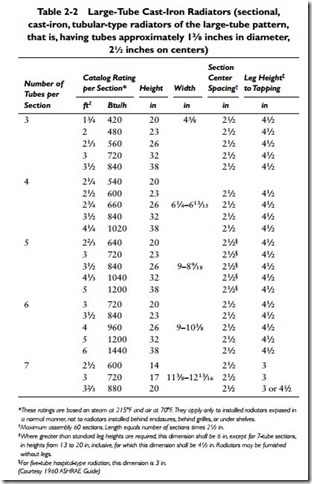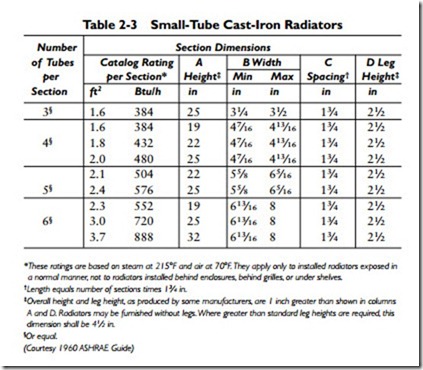Radiator Efficiency
Radiator efficiency is an important operating characteristic of the heating system. The following recommendations are offered as a guide for obtaining higher radiator operating efficiency:
 Table 2-2 Large-Tube Cast-Iron Radiators (sectional, cast-iron, tubular-type radiators of the large-tube pattern, that is, having tubes approximately 13⁄8 inches in diameter, 21⁄2 inches on centers)
Table 2-2 Large-Tube Cast-Iron Radiators (sectional, cast-iron, tubular-type radiators of the large-tube pattern, that is, having tubes approximately 13⁄8 inches in diameter, 21⁄2 inches on centers)
1. A radiator must be level for efficient operation. Check it with a carpenter’s level. Use wedges or shims to restore it to a level position.
2. Make sure the radiators have adequate air openings in the enclosure or cover. The openings must cover at least 40 per- cent of the total surface of the unit.
3. Unpainted radiators give off more heat than painted ones. If the radiator is painted, strip the paint from the front, top, and sides. The radiator will produce 10 to 15 percent more heat at a lower cost.
4. Check the radiator air valve. If it is clogged, the amount of heat given off by the radiator will be reduced. Instructions for cleaning air valves are given in Troubleshooting Radiators in this chapter.
5. Radiators must be properly vented. This is particularly true of radiators located at the end of long supply mains. Instructions for venting radiators are given in Vents and Venting in this chapter.
6. Never block a radiator with furniture or drapes. Nothing should block or impede the flow of heat from the radiator.
7. Placing sheet metal or aluminum foil against the wall behind the radiator will reflect heat into the room.

